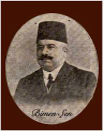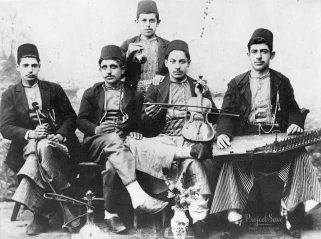An introduction into the most outstanding musicians and their position in society.
An introduction into the most outstanding musicians and their position in society.
By Halim Gençoğlu
The Ottoman Empire, with its vast diversity and multicultural fabric, was home to numerous ethnic and religious groups, among them Armenians, who played a significant role in the empire’s cultural and social life. While the history between Turks and Armenians is often overshadowed by darker chapters, especially for some Armenian rebellions during the late Ottoman period, it is important to highlight the moments of tolerance, collaboration, and cultural exchange that also characterised their relationship. One of the most profound examples of this cultural symbiosis is found in the realm of music, where Armenian musicians not only contributed to Turkish musical traditions but also became integral to the Ottoman cultural identity.
Armenians had a long history in Anatolia, and their presence in the Ottoman Empire was significant, both in terms of their population and the cultural contributions they made. Though they were recognized as a distinct religious and ethnic community, the Ottoman system of millets (autonomous communities) allowed Armenians a certain degree of cultural and religious autonomy. This arrangement fostered an environment where Armenians could thrive in various fields, including trade, arts, and music, while also maintaining their unique identity. However, this autonomy did not lead to isolation. Instead, it encouraged a rich exchange between the Armenian community and the broader Ottoman society. Many Armenians became involved in the Ottoman court and the wider cultural milieu, which facilitated their integration into Turkish society. The social tolerance extended by the Ottomans allowed Armenians to contribute to the arts in ways that left an indelible mark on Turkish culture.
One of the most notable examples of this integration is seen in the field of music, particularly through Armenian composers and musicians who shaped the soundscape of Turkish classical music. Turkish music, especially during the late Ottoman and early Republican periods, was influenced by a variety of ethnic and cultural traditions, including those of the Armenians.
The significance of Armenian Musicians in Turkish culture
The musical contributions of Armenian musicians like Asdik Ağa, Kemani Tatyos Ekserciyan and Bimen Şen are a testament to the deep cultural exchange that existed within the Ottoman Empire. Their works represent a fusion of traditions—blending Armenian melodies with Turkish rhythms and instruments—creating a new and unique musical language that resonated with both Turkish and Armenian audiences.
These musicians were also influential in shaping the development of Turkish classical music, which incorporates a variety of ethnic influences. The Turkish classical music scene, particularly in the 19th and early 20th centuries, was marked by a rich fusion of sounds from different ethnic groups, and Armenians played a central role in this process. The contributions of Armenian musicians helped to shape a distinct Turkish musical identity that was both diverse and inclusive, reflecting the multicultural nature of the empire. Moreover, the integration of Armenians into Turkish culture through music helped foster mutual respect and understanding, despite the political and social challenges of the time. Through their artistry, Armenian musicians were able to transcend ethnic boundaries and become part of a shared cultural legacy that would continue to influence Turkish music long after the dissolution of the Ottoman Empire.
Armenian musicians in the Ottoman Empire
The Ottoman Empire, known for its rich diversity, was home to a wide array of ethnic and religious groups, each contributing to the cultural mosaic of the empire. Among these groups, Armenians held a significant role, especially in the realm of music. Despite the complex and often troubled history between Turks and Armenians, the long centuries of coexistence in the empire saw extensive cultural exchange, particularly in the arts. Armenian musicians, in particular, made lasting contributions to Ottoman music, both in classical and folk traditions.
Armenians in the Ottoman Empire were not only part of the urban elite but also played crucial roles as artists, intellectuals, and musicians. Many Armenian musicians became integral to the Ottoman cultural establishment, contributing to the music of the imperial court, religious ceremonies, and popular music. Their work often bridged the gap between Armenian and Turkish musical traditions, and their influence can still be seen in Turkish music today.
In the Ottoman Empire, music was an essential part of court life, religious practice, and everyday entertainment. The empire was home to a complex musical system that drew on elements from various cultures within its domain, including Arab, Persian, and Byzantine traditions. Armenian musicians not only preserved their own rich musical heritage but also influenced and enriched the broader Ottoman musical landscape.
The Armenian community was well-represented in the Ottoman music scene, particularly in the cosmopolitan urban centers such as Istanbul, Izmir, and Bursa. Many Armenian musicians were trained in both Armenian musical traditions and Ottoman classical music, which was based on the makam system, a complex system of modes used in Turkish classical and folk music.
Armenians played a key role in the development of Ottoman classical music, contributing significantly to the mevlevi music (associated with the Whirling Dervishes), and the court music performed in the imperial palaces. They were also prominent in folk music, especially in the performance of Turkish Türkü and Armenian Duduk music, blending traditional Armenian instruments and melodies with those of Turkish music.
Prominent Armenian musicians in the Ottoman Empire
Asdik Ağa

Asdik Ağa was an Ottoman musician of Armenian origin, who made significant contributions to the classical music traditions of the Ottoman Empire. Little is known about his early life, but he rose to prominence during the 18th century, a period when the empire’s cultural landscape was highly diverse, blending various ethnic and religious influences, including those of Armenians, Greeks, Jews, and Turks. Asdik Ağa’s fame is often tied to his mastery of the Ottoman classical music genre, particularly makam music, which is based on a system of melodic modes that emphasize emotional expression and intricate ornamentation. He was known for his skillful playing of the kemençe (a traditional bowed string instrument) and his role as a composer and performer. His music was characterized by its depth, complexity, and the expressive power that made it popular in the imperial courts and among the broader public. While Asdik Ağa was of Armenian descent, he worked within the Ottoman courtly and urban musical traditions and was part of the cosmopolitan cultural milieu of Istanbul, where different musical and ethnic traditions converged. Armenian musicians were often integral to the development of Ottoman music, and many, like Asdik Ağa, played a crucial role in preserving and transforming these artistic traditions.
Asdik Ağa’s legacy is a reflection of the role those Armenian musicians played in the Ottoman Empire, contributing to the richness of the musical culture while navigating complex cultural and religious dynamics. Despite being of Armenian origin, Asdik Ağa, like many other musicians of his time, did not necessarily emphasize ethnic boundaries in his work, but instead contributed to a shared Ottoman musical heritage that transcended such divisions. His Muhayyer Kürdi Peşrev is still one of the most populars instrumental peace in the Turkish circles.
Tatyos Effendi (Kemani)

Another A prime example of an Armenian musician who left an enduring impact on Turkish music is Kemani Tatyos Ekserciyan.
Tatyos Ekserciyan is best known for his mastery of the violin and his ability to blend traditional Armenian music with the Turkish classical music of his time. The song he composed “Gamzedeyim Deva Bulmam” is still very popular in Turkish environments. He composed numerous pieces that are still performed today in Turkish music circles, often incorporating elements from both Armenian and Turkish musical traditions. His works not only enriched Turkish music but also served as a testament to the cultural blending that took place within the Ottoman Empire.
Bimen Şen

Another notable Armenian musician who contributed to Turkish music was Bimen Şen, an Armenian-born violinist and composer who played a significant role in the development of Turkish folk and classical music. His music reflects the deep connections between Turkish and Armenian musical styles, particularly through his innovative violin techniques and the use of Turkish folk melodies in his compositions. Bimen Şen was instrumental in introducing Armenian musical forms into the broader Turkish repertoire, bridging cultural divides and helping integrate Armenian sounds into the Turkish musical identity. Due to one of his famous songs “Günüm Şen..” Mustafa Kemal Atatürk ask him to take Şen (means happy) surname and he accepted Şen surname in 1934.
Like Tatyos Ekserciyan, Şen’s work exemplified how Armenian musicians were not only key figures in preserving their own musical heritage but also instrumental in shaping the broader cultural and musical landscape of the Ottoman Empire.
The Armenian influence on Ottoman Music
Armenian musicians in the Ottoman Empire were instrumental in developing the intricate relationship between Eastern and Western musical traditions. As part of their training, many Armenian musicians learned both traditional Armenian music and Ottoman classical music, allowing them to serve as cultural intermediaries. This blend of styles led to the creation of a unique musical identity that was reflective of the Empire’s diverse population.

One of the most notable contributions of Armenian musicians to Ottoman music was their involvement in the creation and development of the Ottoman classical music tradition, which was built around the makam system. The makam system is a complex structure of modes that serves as the foundation of much of Turkish music, and Armenian musicians, with their deep understanding of modal systems in both their own music and Ottoman music, were key figures in its development.
In addition to their contributions to court music, Armenian musicians were also influential in folk music. Instruments such as the duduk (a traditional double-reed woodwind instrument) and kemençe (a stringed instrument) became part of the broader Turkish music culture thanks to Armenian musicians. The blending of Armenian melodies with Turkish rhythms gave rise to a vibrant musical tradition that transcended ethnic boundaries.
Cultural integration through music
The contributions of Armenian musicians to Ottoman music serve as an example of the multicultural integration that characterized the Ottoman Empire. Despite the political and social challenges that often existed between different communities, music was one of the primary vehicles for cultural exchange. Armenian musicians, through their participation in Ottoman musical life, helped bridge the divide between different ethnic and religious groups.
This integration through music was not just a matter of artistic collaboration but also a reflection of the broader social tolerance in the empire. Armenians, while maintaining their distinct identity, were able to engage with and contribute to the dominant cultural traditions of the Ottoman state. This cultural synthesis, particularly through music, played a significant role in shaping the cosmopolitan nature of Ottoman society.
Conclusion
Armenian musicians in the Ottoman Empire were not only skilled artists but also cultural ambassadors, fostering a deeper understanding and exchange between different ethnic and religious groups. Their contributions to both classical and folk music enriched the Ottoman musical tradition and helped to shape the soundscape of the empire. Musicians like Kemani Tatyos Ekserciyan and Bimen Şen exemplify the integration of Armenian and Turkish cultural elements, showcasing the rich, collaborative nature of Ottoman society. Today, their legacies continue to resonate in both Turkish and Armenian music, reminding us of the enduring power of cultural exchange and tolerance.
The example of Armenian musicians like Kemani Tatyos Ekserciyan and Bimen Şen highlights the importance of tolerance and cultural integration within the Ottoman Empire. Their contributions to Turkish music not only enriched the cultural heritage of the empire but also demonstrated how cultural exchange can transcend ethnic and religious divisions. While the Ottoman Empire was marked by its complexities and tensions, the collaborative and integrative efforts of Armenians in the arts, particularly music, are an enduring reminder of the rich tapestry of cultural interconnections that defined much of the empire’s history.
These musicians stand as examples of how, despite the challenges of history, artistic expression can unite diverse communities, leaving a lasting legacy of cultural fusion that continues to influence both Turkish and Armenian culture today.
In this regard, the unfair allegation of the Armenian genocide against the Ottoman Empire must be re-examined in a broader context. Studies have shown that real instances of genocide in history were driven by different social pressures and cruelties. African history has many barbaric examples which are completely different than relations between Armenians and Turks.
There is no example in history where; after listening to an Armenian musician like Tatyos Effendi, one would then attack the great musician like him. The claims made by the Armenian lobby in America against the Turks are not accurate. If there was such tolerance toward minorities in the Ottoman Empire, then the question of what provoked the Armenians to rebel, thereby damaging centuries of friendship between Turks and Armenians, must be objectively analyzed in light of comparative sources.
Bibliography
- Tarkan, S. Osmanlı İmparatorluğu’nda Ermeni Müzisyenleri ve Müzik Kültürü [Armenian Musicians and Music Culture in the Ottoman Empire]. İstanbul: İstanbul Üniversitesi Yayınları, 2019.
- Erkin, A. Türk ve Ermeni Müzik Kültürünün Bütünleşmesi [The Integration of Turkish and Armenian Musical Cultures]. Ankara: Kültür Bakanlığı Yayınları, 2021.
- Kök, H. Osmanlı Sarayı ve Ermeni Müzik Geleneği [The Ottoman Palace and Armenian Music Tradition]. İstanbul: Müzik Yayıncılık, 2020.
- Yılmaz, N. Ermeni Müzisyenlerin Osmanlı Müzik Kültüründeki Yeri [The Role of Armenian Musicians in Ottoman Music Culture]. Türk Musikisi Araştırmaları 32 (2018): 51-75.
- Aydın, M. Osmanlı Döneminde Müzik ve Ermeni Sanatçılar [Music and Armenian Artists in the Ottoman Period]. Ankara: Akıl Yayıncılık, 2017.
- Balkaya, E. Ermeni Müzik Tarihi Üzerine Çalışmalar [Studies on Armenian Music History]. İstanbul: Boğaziçi Üniversitesi Yayınları, 2020.
- Büyükerdem, E. “Tatyos Ekserciyan’ın Osmanlı Müzik Kültüründeki Yeri” [The Place of Tatyos Ekserciyan in Ottoman Music Culture]. Türk Müzikolojisi Dergisi, 34 (2022): 113-138.
- Kaya, B. Ermeni Müzik Aletlerinin Türk Müzik Kültürüne Katkıları [Contributions of Armenian Musical Instruments to Turkish Music Culture]. İstanbul: Müzik Vakfı Yayınları, 2019.
- Kashkarian, G. “Armenian Musicians in the Ottoman Empire: A Study of Cultural Exchange.” Middle Eastern Music and Culture, 2023.
- Şahin, O. Osmanlı İmparatorluğu’nda Ermeni Müzikçiler ve Toplumsal Bütünleşme [Armenian Musicians in the Ottoman Empire and Social Integration]. Osmanlı Araştırmaları Dergisi, 45 (2020): 95-120.
- Öztuna, Yılmaz. 2000. Türk Musikisi Ansiklopedisi [Encyclopedia of Turkish Music]. Vol. 1. Istanbul: Müzik Ansiklopedisi Yayınları.

















Leave a Reply